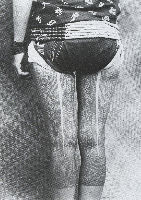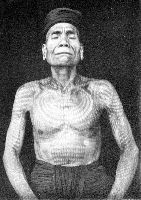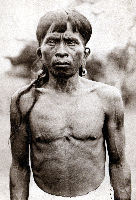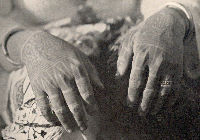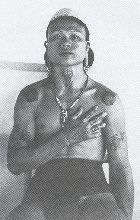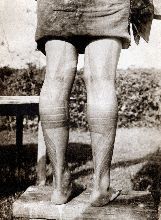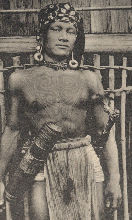
|
||||||||||
| Celeb Tattoos | Facts & Stats | Designs & Symbols | History | Culture | Links | Tattoo Galleries | Contact | ||||||||||
Among the tribes in Borneo, tattooing is mainly associated with headhunting (a visible sign of success) for men and the coming of age of women - in some cases it symbolizes their social status. Tattoos are part of the "rites of passage" and next to blackened teeth and long ear-lobes, intricate tattoos on fingers, hands, lower arms, thighs, calves, and feet served as important elements of beauty for women. The darker the color, the better. Click on any of the images below to view full size. Use your browser's BACK button to return. Get detailed explanations of some of these photos and others. Borneo trip photos from the filming of our tribal tattoo documentary!
Tribes of BorneoApo-Kayans - Apo Kayan means the Kayan hill country bordering Sarawak- "A young woman's social position is also indicated, among other things, by the number of rings around the calves of her legs. It appears that originally the significance of the tattooing was as a protective device." (Tillema [ca. 1924-1927] 1989) Actually, it enabled them to travel to the land of the ancestors... see below... The Apo-Kayans are a subgroup of the Dayak people (Dyak). They live in the central and eastern portions of Borneo - also in Sarawak. This entire cultural grouping is non-Muslim and indigenous to the area living along the banks of rivers in community longhouses. Communities number no more than a few hundred and they trace their descent through male and female lines (matrilineal and patrilineal descent). The Kenyah are also a part of this subgroup and live in the general area. The Kayan and Kenyah (speak different languages) have a caste system recognizing three distinct tiers of society: 1) family and relatives of village chiefs, 2) common villagers, 3) captives of war, outcastes, and vagabonds. The Iban are another subgroup also known as the Sea Dayak of Sarawak and have no class distinction to speak of. Generally speaking, the indigenous peoples of Borneo are agrarian hunter-gatherers, cultivating rice on the hills and supplementing this with fish and game (utilize hunting dogs and lances for wild pig; blowpipes for smaller game). They employ the use of spears, blowpipes, and other iron implements. The ceremonial complex is highly developed and can be characterized by animism and polytheism. Worship focuses upon a supreme god of the upper world (who is male) and a god of the underworld (who is female). Numerous spiritual entities roam the jungles, good and bad, acknowledging their own lords. These rajas/lords are usually priests or priestesses. When possessed, they speak in the tongue of the spirits, "spirit language." Death chants are a feature of these shamans which are believed to release the soul of the deceased to the land of ancestors. Many such rituals include a strong sexual symbolism and contact. People are buried within wooden coffins for several years to be later exhumed and deposited into a raised burial platform - crypts on stilts. Of course, and in former days, intertribal warfare was common with headhunting as a major feature in their milieu. The Muruts (translates to "hill people") are the third largest indigenous group in Sabah - Northern Borneo. They are also agrarian hunter-gatherers who often shift locations and settle in more remote areas of Tenom, Keningau, and Pensiangan. They also live in community longhouses near rivers and were the last of Sabah's ethnic peoples to renounce head hunting.
The Dusuns are hill rice people as well, living in southeastern Kalimantan region near Mt. Kinabalu, the highest mountain in S.E. Asia. Tribal tattoo distinctionsMuruts - Men who have fought, or who have gone on risky expeditions (headhunting I presume) are tattooed from the shoulders to the pit of the stomach, and all down the arms three-parallel stripes to the waist. (Hatton 1882) NOTE: This tattooing is similar to that of Siberut Island... Rundum Muruts - stars on the front of the shoulder, above the breast, are often seen... each star denoted a head having been taken. When the third had been taken, another star was placed on the throat; then the forearms and thighs were tattooed, but with no special design. (Rutter 1929) Dusun (near Mt. Kinabalu) Tambunan Valley - bordering chiefs (Muslim chiefs) used to reconcile the Dusun by giving the aggrieved community some slave to dispose of; this is done by tying the slave up and spearing him through the thorax, then the men of the village each take a cut at the quivering body (slowly bleeding them to death). Whomever does this has the right to tattoo himself. (Alman 1963) Kayans - A man is supposed to tattoo one finger only, if he has been present when an enemy has been killed, but tattoos hands and fingers if he has taken an enemy's head. The chiefs, however, often break with this rule, and have the whole of their hands tattooed if they have participated in war expeditions. (Hose 1894)
At Long Nawang - Apo Kayan, Central Borneo - The chiefs of this village must give their consent for tattooing of the women. Tattooing of women affects men in very unpleasant ways as the result of the magic it works. For this reason, it is only permitted at intervals of six years or more, and when the process is completed, a celebration is held. The celebration counteracts the bad influences which threaten the men. But women sometimes go ahead with it anyway, without the chief's consent, and they then go to the Ma Kulit (Koelit), a tribe known for its skillful tattooing of women. LiteratureAlman, J.H. 1963. "Notes on Tatooing in North Borneo." Journal of the Sabah Society 4: 78-88. Hatton, F. [1882]. Diary of Frank Hatton Esq., During a Mineral Exploration Journey up the Labuk River and Overland to Kudat. Hose, C. 1894. "The Natives of Borneo." Journal of the Anthropological Institute of Great Britain and Ireland 23: 156-172. Rutter, O. 1929. The Pagans of North Borneo. London: Hutchison & Co. Tillema, H.F. 1989. A Journey Among the Peoples of Central Borneo in Word and Picture. Oxford: Oxford University Press. Witti, F. [1880]. Diary of F. Witti Esq., During an Excursion in North Borneo from Maruda Bay to Papar. |
||||||||||
|
Research by Lars Krutak |
||||||||||
To Borneo and the land of the headhuntersTattoo images through history |
||||||||||
| Celeb Tattoos | Facts & Stats | Designs & Symbols | History | Culture | Links | Tattoo Galleries | Contact | ||||||||||
